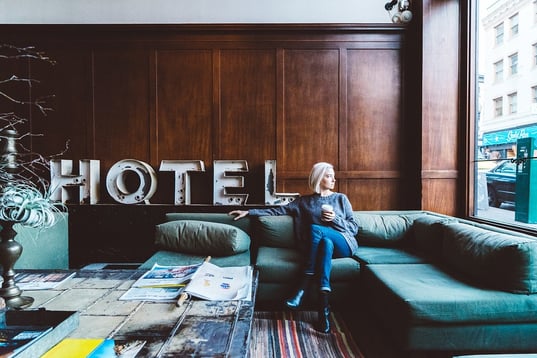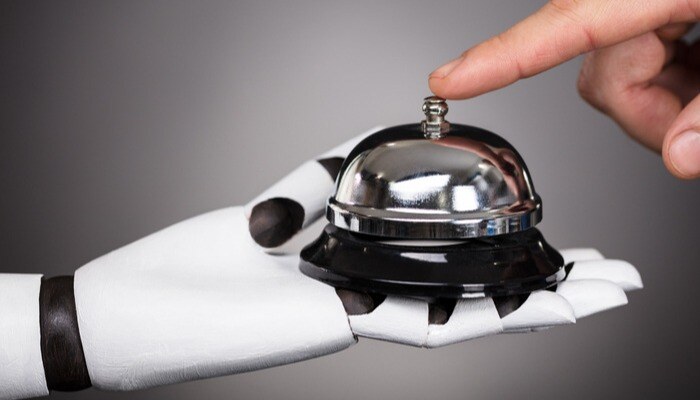
You’ve likely experienced failure before. Very few professionals in the hospitality industry reach the pinnacle of success without falling flat along the journey, despite their best efforts.
The best way to avoid repeating hotel management failures is to learn from them. At the same time, staying ahead of 2025's hospitality design trends can help you manage the current with ease (instead of swimming up a waterfall).
What are we getting at? These days, hospitality design management requires thinking beyond the numbers.Before you achieve a hotel project with a dream revenue stream, you must first master a detailed administrative agenda. And it starts with avoiding modern design no-nos.
Avoid These Hospitality Management & Design Failures
1. Falling Behind the Tech Curve
Ten years ago, you may not have installed guest Wi-Fi yet (or you at least were charging for it). Today’s ever-connected guests couldn’t comprehend such a thing. In another 10 years, technology will have evolved further to allow amazing advances in service personalization and mass customization.
Consider this: In 2018, robots were already becoming programmed hospitality masters. Back then, we were also seeing hotels automate housekeeping and maintenance.

If you’re willing to trust the promise of ROI technology’s omnipresence can bring, there are surefire ways to delight the socks off device-fixated hotel guests:
- Guest room smart devices and voice recognition software can cater to every need and desire.
- Smart TVs with streaming capabilities can provide guests access to their own content; health enthusiasts’ favorite exercise programs, movie fanatics to their favorite cinema lineup or Netflix series.
- AI personalization can optimize elements such as lighting to promote sleep, concentration, and physical activity.
- Even AI chatbots and virtual concierges are trickling into hospitality, offering real-time assistance and personalized suggestions.
By the way, cell phone ownership is up to 98% among adults in the United States. About 53% own a tablet. The very least you could do is give them easily accessible places to plug them in while they travel.
2. Choosing Poorly Crafted Furniture
The pull toward saving money is understandably strong. But buyer beware: You get what you pay for. Some industry experts believe saving $1 unwisely could ultimately cost you $10.
Unfortunately, the following nightmare supply chain scenario is all too common:
- An overseas manufacturer makes and ships your custom hotel casegoods furniture for less money than stateside options you’ve researched
- It arrives late due to being held up at port, and the project falls behind schedule
- You discover during installation that more replacement parts are required than originally accounted for. A new order is placed, which will take another 4-6 weeks to be processed and shipped
- After installation, poor craftsmanship leaves your hotel in a costly repair-and-replacement cycle well before the next scheduled renovation/update
Your guest’s satisfaction relies heavily on their comfort within the guestroom. When it comes to lower-quality furniture, you should expect your guests to literally feel the discomfort. And with a few, quick taps on the smartphone, they’ve submitted a scathing online review complete with pictures, video, and commentary for the world to see for years to come.
In hindsight, the domestic option seems pretty logical, right?
3. Sustainability
Modern travelers are increasingly drawn to brands that demonstrate at least some environmental morality. You can manifest this in your hotel brand in several ways:
- Technology – Energy-efficient systems and software that helps with resource management can save both money and waste.
-
Materials – It's easier than ever to find materials that are renewable, biodegradable, and low in VOCs (volatile organic compounds). Sustainable-yet-stylish materials include bamboo, cork, reclaimed materials, organic fabric (i.e. hemp), and more.
-
Manufacturing processes – Eco-conscious hotel designers can take their commitment even deeper by vetting whether their suppliers' production methods are sustainable.
4. Bad Investment Planning
Buy low; sell high. Wall Street investors live and die by that credo. Ideally, we’d all love to enter the market when prices are cheap and leave with the greatest gains.
In your case, investment – while ultimately tied to financial returns – means more than money alone.
A successful investment strategy considers the interplay between budget, property potential, and – most importantly for your guests – the physical spaces you create.
Today's travelers have higher expectations for the “experience.” Your interior hotel design, including the furniture, is a huge part of that. Furniture that’s outdated or screams “cheap” can dash the perceptions of luxury and value, no matter how strong your location or branding.
Investing in high-quality, adaptable, and durable furniture is sure to boost guest satisfaction and brand recognition. Action items for your planning list could include:
-
Evaluate Long-Term Value – Choose casegood materials that’ll withstand high traffic and frequent use without sacrificing aesthetics. Take the item’s function and location into consideration.
-
Be Different by Design – Lean on custom hospitality furniture, which is more likely to make your space feel unique to visitors. This will better reflect your brand’s identity and help you stand out in a crowded market.
-
Think Modular & Flexible – Adaptable furniture can modernize a hotel space while also expanding its usefulness. Multifunctional rooms and reconfigurable pieces can help you address evolving guest needs, from wellness-focused amenities to co-working spaces.
No one has a real, functioning crystal ball. Make educated guesses to determine if the sum of all your efforts will pay off.
5. Failure to Adjust
Read the room!
In a dynamic hospitality market, sticking with outdated strategies can lead to stagnation. Adjusting to new realities requires more than reactive rate hikes – it also calls for proactive innovation that aligns with guest expectations and efficient operation.
Inflation, changing demographics, and growing environmental awareness shape the hospitality landscape. While strategies like adding facility fees have gained traction, today’s adjustments go beyond pricing. Again – travelers increasingly prioritize value, experience, and sustainability, meaning hotel managers must rethink how every aspect of their property contributes to guest satisfaction and ROI.
For example: Misuse of guest room space is a crime! Every customer-facing square foot should be an opportunity – or two – to add value and generate revenue. Thoughtful furniture investments can help convert underused areas into revenue streams. Consider modular furniture, which can dual-repurpose a lounge into a co-working hub by day and a social space at night. For many modern travelers, flexible and space-saving hotel design ensures they think of your experience as adaptable and relevant to their needs.
For example, you've probably noticed the rise of the "Work From Hotel" movement. Your casegood choices should already be accommodating those who need functional workspaces in their guest rooms.
And don't make the mistake of underestimating the "bleisure" travel trend, either. Many business travelers are bringing along their families or extending the trip to meet up with friends. Is your hotel design adapting to these visitors' needs for dedicated work zones and high-tech amenities?
Year-to-year, lifestyle, economic, and political changes cause industries everywhere to rethink paths to profitability. Hospitality should be no different.
Avoid a Failed Hospitality Design Project with Proper Preparations and Adjustments
Your project may be several years from breaking ground or beginning renovations. Financial realities will fluctuate, while the demand for quality and innovation will never cease.
Entering 2025, hotel design trends show that all of that is happening elsewhere right now. Educate yourself to better delight guests and gain a stronger foothold for ROI.
Are you leveraging your furniture as a branding tool to create memorable guest experiences? Or, at the very least, are your furniture choices maximizing guest comfort and usability while keeping replacement costs low?
By strategically investing in high-quality, sustainable, and versatile casegoods design, you’re not just furnishing a space. You’re also crafting an experience that demands repeat visits and profits you in the long term.
(Editor's note: This article was originally published in January 2018 and was recently updated)

